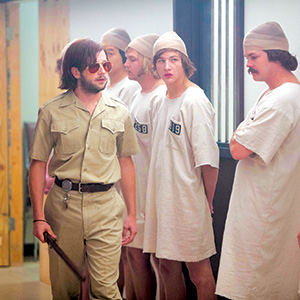
It has been the source for so many anecdotes that skeptics tend to believe it’s an urban legend. But the Stanford Prison Experiment actually occurred, 44 years ago this summer, in the basement of Jordan Hall on the Stanford University campus.
Kyle Patrick Alvarez’s The Stanford Prison Experiment is the third film in 15 years about Dr. Philip Zimbardo’s infamous psychological experiment. I’m not counting 2002’s Experiment, when BBC and the University of Exeter tried to reproduce the results of the study. The new film—the one with Zimbardo’s name on it—spent at least 14 years in development hell.
Zimbardo took a test group and divided them by coin-toss into prisoners and guards. They were herded, three apiece, into three separate “cells”—a makeshift prison constructed out of trio of vacant classrooms. In record time, things got ugly—the “prisoners” rebelled, ripping up their uniforms and tearing up their bunks. The “guards” responded with savagery, with forced exercises and sleep disruptions. Says prisoner #819, born Peter (Tye Sheridan): “Is it just me or are they taking this way too seriously?” The students sink into their roles, despite the bitterness of actual ex-con (Nelsan Ellis) observing the results: “You brought me here to legitimize this experiment. This experiment has nothing legitimate about it.” Scheduled for two weeks, the experiment only lasted six days.
I’d speculate that two matters contaminated Zimbardo’s petri dish. The first was cinema. People in a new experience, especially anything to do with breaking the law, tend to reach for their memories of the movies. The imprisoned students behaved in terms of the anti-authoritarian films and books of 1971. In Alvarez’s film, one of the newly fledged jailbirds assumes an Edward G. Robinson drawl. The guards went tough as southern sheriffs. The most brutal, Christopher (Michael Angarano) emulates Strother Martin in Cool Hand Luke—if you’ve never seen the Paul Newman classic, perhaps you heard Willem Dafoe imitate Martin’s evil whine as Rat in Fantastic Mr. Fox.
Secondly, trying to keep this film contemporary—the stocking caps the prisoners wear makes them look like corner skateboarders—Alvarez ignores the elephant in the room, Vietnam. The study was carried out at the behest of the military, though this isn’t mentioned here. The draft board waited to scoop up students who flunked out—a cause of more pressure, and more paranoia, for these students than just the matter of their $15 a day stipend. Alvarez seems mostly interested in the era for the novelty of the clothes: the clown lapels, bushy haircuts and the napkin-sized ties.
Credit Alvarez with a sly sense of humor, manifested in what he allows in Billy Crudup’s performance as Zimbardo. Zimbardo later wrote a flamboyantly titled book about his experiences, The Lucifer Effect. Alvarez seems to have taken Lucifer to heart when shaping the role of the test’s leader. The best thing I’ve ever read about Crudup was a critic calling him “covert.” This wasn’t meant as a compliment, but, to me, it is one—I prefer slippery and shadowy to cut and dried. Crudup smiles thinly through a devilish beard keeping up nocturnal spying on his test subjects (those who sit and watch burn out, too).
Also grimly amusing is the amateur hour-ness of the guards when they start out trying to do their duty of stripping their prisoners and spraying them for lice—you’ve seen greater displays of authority at a fraternity hazing. The humor wears off. We’re meant to take the hysteria seriously in the name of Abu Ghraib, and shake our heads over the disciplinarians who approve the sadism. The most interesting of them is Albert Malafronte as one Father MacAllister: a sky-pilot on autopilot.
Alvarez, trying to thicken the boiler-room intensity, hired Andrew Hewitt for a soundtrack of synthesizer lowing and electronic chimes. There’s relevance here, but not much more than relevance—the walls close in, but Alvarez and his good cast can’t make this immurement real. Squeezed by dungeon melodramas like Saw on the one side and cruel reality TV shows on the other, The Stanford Prison Experiment can’t raise a hackle or a thrill.
The Stanford Prison Experiment
R; 122 Mins.


